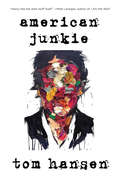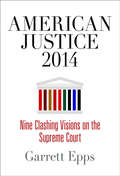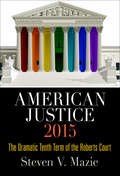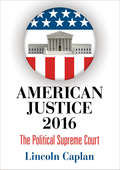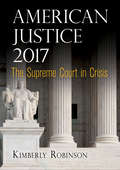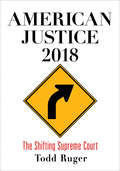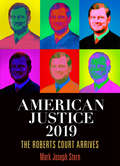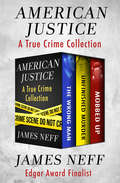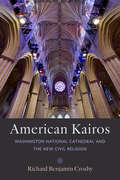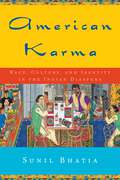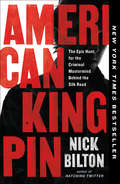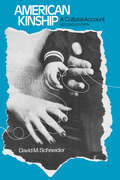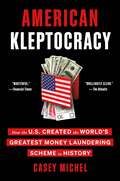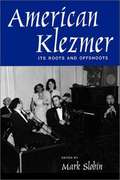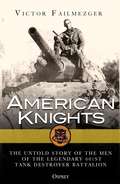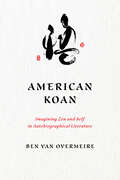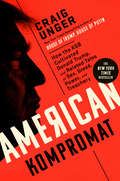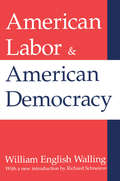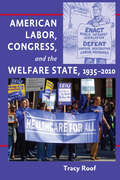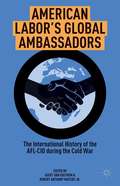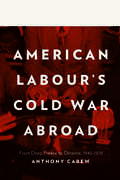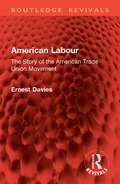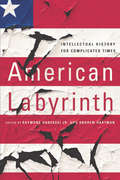- Table View
- List View
American Junkie
by Tom HansenA non-stop trip into one man's land of desperate addicts, failed punk bands, and brushes with sad fame, as he sells drugs during the Seattle grunge years. In American Junkie, Tom Hansen maps his heroin addiction, from the promise of a young life to the prison of a mattress, from budding musician to broken down junkie, drowning in syringes and cigarette butts, shooting heroin into wounds the size of softballs, and ultimately, a ride to a hospital for a six-month stay and a painful self-discovery that cuts down to the bone. Through it all he never really loses his step, never lets go of his smarts, and always projects quintessential American reason, humor, and hope to make a story not only about drugs, but a compelling study of vulnerability and toughness.
American Justice 2014
by Garrett EppsIn this provocative and insightful digital book, constitutional scholar, novelist, and journalist Garrett Epps examines the recently concluded Supreme Court term, highlighting one revealing opinion or dissent from each Justice. The result is a highly original exploration of the issues before the court as well as an investigation of the Justices as human beings and legal thinkers.
American Justice 2015
by Steven V. MazieAmerican Justice 2015: The Dramatic Tenth Term of the Roberts Court is the indispensable guide to the most controversial and divisive cases decided by the Supreme Court during the past year. Steven Mazie, Supreme Court correspondent for The Economist, examines the term's fourteen most important cases, tracing the main threads of contention and analyzing the expected impacts of the decisions on the lives of Americans. Legal experts and law students will be drawn to the lively summaries of the issues and arguments, while scholars and theorists will be engaged and provoked by the book's elegant introduction, in which Mazie invokes John Rawls's theory of "public reason" to defend the institution of the Supreme Court against its many critics.Mazie contends that the Court is less ideologically divided than most observers presume, issuing many more unanimous rulings than 5-4 decisions throughout the term that concluded in June 2015. When ruling on questions ranging from marriage equality to freedom of speech to the Affordable Care Act, the justices often showed a willingness to depart from their ideological fellow travelers--and this was particularly true of the conservative justices. Chief Justice Roberts joined his liberal colleagues in saving Obamacare and upholding restrictions on personal solicitation of campaign funds by judicial candidates. Justice Samuel Alito and the chief voted with the liberals to expand the rights of pregnant women in the workplace. And Justice Clarence Thomas floated to the left wing of the bench in permitting Texas to refuse to print a specialty license plate emblazoned with a Confederate flag. American Justice 2015 conveys, in clear, accessible terms, the arguments, decisions, and drama in these cases, as well as in cases involving Internet threats, unorthodox police stops, death-penalty drugs, racial equality, voting rights, and the separation of powers.
American Justice 2016: The Political Supreme Court
by Lincoln CaplanWhen the Democrat-appointed Justice Ruth Bader Ginsburg criticized Republican presidential nominee Donald Trump, she triggered concerns about judicial ethics. But the political concerns were even more serious. The Supreme Court is supposed to be what Alexander Hamilton called "the least dangerous" branch of government, because it is the least political. Justices have lifetime appointments to ensure their "complete independence" when deciding cases and controversies. But in the Roberts Court's most contested and important rulings, it has divided along partisan lines for the first time in American history: Republican presidents appointed the conservatives, Democrats appointed the liberals. Justice Ginsburg's criticisms suggested that partisan politics drive the Court's most profound disagreements. Well-respected political science supports that view.Has this partisan turn made the Court less independent and less trustworthy than the nation requires? The term ending in 2016 included more decisions and developments in almost fifty years for analyzing this question. Among them were major cases about abortion rights, the death penalty, immigration, and other wedge issues, as well as the death of Justice Antonin G. Scalia, leaving the Court evenly divided between conservatives and liberals. Legal journalist Lincoln Caplan dissects the recent term, puts it in historical context, and recommends ways to strengthen trust in the Supreme Court as the pinnacle of the American constitutional system.
American Justice 2017: The Supreme Court in Crisis
by Kimberly RobinsonWith the death of associate justice Antonin Scalia, the Supreme Court was plunged into crisis. Refusing to hold hearings or confirm the nominee of a Democratic president almost a year away from a presidential election, the Republican-controlled Senate held the court hostage, forcing it to do its work through nearly the entire term ending in June 2017 with just eight justices. In American Justice 2017: The Supreme Court in Crisis, Kimberly Robinson examines the way individual justices and the institution as a whole reacted to this unprecedented, politically fraught situation.In public, the justices put on brave faces, waiting for the confirmation battle to play itself out, while indicating in occasional statements that the court would muddle through just fine. In private, though, things appear to have been more complicated. Narrow decisions, lackluster choice of cases, and odd bedfellows teaming up on the same sides of opinions and dissents give us a hint of the strenuous effort the eight justices made to uphold the integrity of the institution in the face of hurricane-force partisan gales.
American Justice 2018: The Shifting Supreme Court
by Todd RugerAfter a restrained 2017 term in which the Supreme Court muddled through most of its work with just eight justices, the court roared back to life with a momentous term in 2018. With Donald Trump's first appointment to the bench, conservative Justice Neil Gorsuch, finding his footing and swing-vote Justice Anthony Kennedy preparing for retirement at the close of the term, the Court took on a series of cases that touched on some of the most contentious issues in contemporary American life—and in almost every case gave Americans a glimpse of where the court is likely to keep shifting over the coming years: further to the right.In American Justice 2018, journalist Todd Ruger examines the most monumental of these controversial decisions—including those involving religious freedom and minority rights, partisan gerrymandering, President Trump's travel ban, privacy in the digital era, sales tax for online retailers, and apparent tensions between the First Amendment and the collection of union dues. Ruger deftly analyzes how each of these decisions fits into the history of the court—and what the opinions and dissents reveal about the shifting ideological configuration of the institution. Along the way, Ruger reflects on how the term's polarizing docket will shape the future of the Supreme Court and the legacy of individual justices.
American Justice 2019: The Roberts Court Arrives
by Mark Joseph SternFollowing the retirement of Justice Anthony Kennedy and the controversial confirmation of Justice Brett Kavanaugh, the Supreme Court plunged into a contentious term that featured divisive cases involving abortion, immigration, capital punishment, and voting rights on the court's docket. In American Justice 2019, Mark Joseph Stern examines the term's most controversial opinions and highlights the consequences of Chief Justice John Roberts stepping into a new role as the court's swing vote.No longer bound by Kennedy's erratic moderation, Roberts has begun doling out victories to both Democrats and Republicans, albeit with a clear rightward tilt. Early in the term, Roberts delivered a public rebuke to Trump's attacks on the judiciary, foreshadowing his refusal to tolerate some of the president's most extreme contortions of the law. Stern tracks the chief justice's evolution from staunch conservative to part-time centrist. Along the way, he details the term's blockbusters and surprises, including an unlikely alliance between Justices Neil Gorsuch and Sonia Sotomayor on criminal justice, and an especially radical ruling on the death penalty that overturned decades of precedent. Stern's account depicts a court sharply divided over its role in American democracy, with the man at its center striving to stay above the political fray without abandoning his conservative instincts.
American Justice: A True Crime Collection
by James NeffThree shocking tales of violence, intrigue, and the search for truth from a two-time Edgar Award finalist and Ann Rule&’s &“favorite true-crime writer.&” In this riveting collection, prize-winning investigative journalist James Neff examines the Dr. Sam Sheppard murder mystery; the terrifying pursuit of a serial rapist in Cleveland, Ohio; and the spectacular rise and fall of Teamster boss Jackie Presser. The Wrong Man: In 1954, in suburban Cleveland, Dr. Sam Sheppard&’s wife, Marilyn, was beaten to death in their home. Investigators, the press, the public, and the courts worked in lockstep to convict Sheppard. Sentenced to life in prison, he served nearly a decade before he was acquitted in a retrial. Culled from DNA evidence, testimony that was never heard in court, prison diaries, and interviews with key players, The Wrong Man makes a convincing case for Sheppard&’s innocence and reveals the identity of the true killer. &“Gripping and meticulously researched . . . [A] first-degree murder mystery&” (People). Unfinished Murder: From 1983 to 1988, serial rapist Ronnie Shelton preyed on the women of Cleveland. Dubbed the West Side Rapist, he spied on his victims, stalked them, and brutally assaulted them in their homes. Arrested at least fifteen times for other crimes, Shelton slipped through the cracks of the justice system so often it seemed he&’d never be caught—until his courageous victims united to put him behind bars. A finalist for the Edgar Award, Unfinished Murder is based on more than 150 interviews with the survivors, the police, psychiatrists, and Shelton himself, who was sentenced to 3,195 years in prison, the longest in Ohio state history. Mobbed Up: As the president of America&’s largest labor union, Jackie Presser navigated a dangerous balancing act with the Teamsters, the Mafia, and the Justice Department. At the same time he was taking orders from New York mob boss Fat Tony Salerno, Presser was serving as the FBI&’s top informant on organized crime. Drawing on thousands of pages of classified files, Neff follows the trail of greed and hubris all the way to the Nixon and Reagan White Houses, where Presser was treated as a valued friend. &“[A] damning tale . . . A portrait of pervasive corruption that should concern anyone who cares about the way this country works&” (Los Angeles Times).
American Kairos: Washington National Cathedral and the New Civil Religion
by Richard Benjamin CrosbyA history of Washington National Cathedral and the theory of an American civil religion.In 1792, Pierre Charles L'Enfant, the first city planner of Washington, DC, introduced the idea of a "great church for national purposes." Unlike L'Enfant's plans for the White House, the US Capitol, and the National Mall, this grand temple to the republic never materialized. But in 1890, the Episcopal Church began planning what is known today as Washington National Cathedral. In American Kairos, Richard Benjamin Crosby chronicles the history of not only the building but also the idea that animates it, arguing that the cathedral is a touchstone site for the American civil religion—the idea that the United States functions much like a religion, with its own rituals, sacred texts, holy days, and so on. He shows that the National Cathedral can never be the church L'Enfant envisioned, but it can be a starting point for studying the conflicts over belonging, ideology, and America's place in the world that define the American civil religion. By examining correspondence between L'Enfant, George Washington, Thomas Jefferson, and others, and by diving into Washington National Cathedral's archives, Crosby uncovers a crucial gap in the formation of the nation's soul. While L'Enfant's original vision was never realized, Washington National Cathedral reminds us that perhaps it can be. The cathedral is one of the great rhetorical and architectural triumphs in the history of American religion. Without government mandate or public vote, it has claimed its role as America's de facto house of worship, a civil religious temple wherein Americans conduct some of their highest, holiest rituals, including state funerals and National Day of Prayer services.
American Karma: Race, Culture, and Identity in the Indian Diaspora (Qualitative Studies in Psychology #11)
by Sunil BhatiaThe Indian American community is one of the fastest growing immigrant communities in the U.S. Unlike previous generations, they are marked by a high degree of training as medical doctors, engineers, scientists, and university professors.American Karma draws on participant observation and in-depth interviews to explore how these highly skilled professionals have been inserted into the racial dynamics of American society and transformed into “people of color.” Focusing on first-generation, middle-class Indians in American suburbia, it also sheds light on how these transnational immigrants themselves come to understand and negotiate their identities.Bhatia forcefully contends that to fully understand migrant identity and cultural formation it is essential that psychologists and others think of selfhood as firmly intertwined with sociocultural factors such as colonialism, gender, language, immigration, and race-based immigration laws.American Karma offers a new framework for thinking about the construction of selfhood and identity in the context of immigration. This innovative approach advances the field of psychology by incorporating critical issues related to the concept of culture, including race, power, and conflict, and will also provide key insights to those in anthropology, sociology, human development, and migrant studies.
American Kingpin: The Epic Hunt for the Criminal Mastermind Behind the Silk Road
by Nick BiltonThe unbelievable true story of the man who built a billion-dollar online drug empire from his bedroom—and almost got away with it In 2011, a twenty-six-year-old libertarian programmer named Ross Ulbricht launched the ultimate free market: the Silk Road, a clandestine Web site hosted on the Dark Web where anyone could trade anything—drugs, hacking software, forged passports, counterfeit cash, poisons—free of the government’s watchful eye. It wasn’t long before the media got wind of the new Web site where anyone—not just teenagers and weed dealers but terrorists and black hat hackers—could buy and sell contraband detection-free. Spurred by a public outcry, the federal government launched an epic two-year manhunt for the site’s elusive proprietor, with no leads, no witnesses, and no clear jurisdiction. All the investigators knew was that whoever was running the site called himself the Dread Pirate Roberts. The Silk Road quickly ballooned into $1.2 billion enterprise, and Ross embraced his new role as kingpin. He enlisted a loyal crew of allies in high and low places, all as addicted to the danger and thrill of running an illegal marketplace as their customers were to the heroin they sold. Through his network he got wind of the target on his back and took drastic steps to protect himself—including ordering a hit on a former employee. As Ross made plans to disappear forever, the Feds raced against the clock to catch a man they weren’t sure even existed, searching for a needle in the haystack of the global Internet. Drawing on exclusive access to key players and two billion digital words and images Ross left behind, Vanity Fair correspondent and New York Times bestselling author Nick Bilton offers a tale filled with twists and turns, lucky breaks and unbelievable close calls. It’s a story of the boy next door’s ambition gone criminal, spurred on by the clash between the new world of libertarian-leaning, anonymous, decentralized Web advocates and the old world of government control, order, and the rule of law. Filled with unforgettable characters and capped by an astonishing climax, American Kingpin might be dismissed as too outrageous for fiction. But it’s all too real.
American Kinship: A Cultural Account, Second Edition
by David M. SchneiderAmerican Kinship is the first attempt to deal systematically with kinship as a system of symbols and meanings, and not simply as a network of functionally interrelated familial roles. Schneider argues that the study of a highly differentiated society such as our own may be more revealing of the nature of kinship than the study of anthropologically more familiar, but less differentiated societies. He goes to the heart of the ideology of relations among relatives in America by locating the underlying features of the definition of kinship—nature vs. law, substance vs. code. One of the most significant features of American Kinship, then, is the explicit development of a theory of culture on which the analysis is based, a theory that has since proved valuable in the analysis of other cultures. For this Phoenix edition, Schneider has written a substantial new chapter, responding to his critics and recounting the charges in his thought since the book was first published in 1968.
American Kleptocracy: How the U.S. Created the World's Greatest Money Laundering Scheme in History
by Casey MichelA remarkable debut by one of America's premier young reporters on financial corruption, Casey Michel's American Kleptocracy offers an explosive investigation into how the United States of America built the largest illicit offshore finance system the world has ever known."An indefatigable young American journalist who has virtually cornered the international kleptocracy beat on the US end of the black aquifer."—The Los Angeles Review of Books For years, one country has acted as the greatest offshore haven in the world, attracting hundreds of billions of dollars in illicit finance tied directly to corrupt regimes, extremist networks, and the worst the world has to offer. But it hasn’t been the sand-splattered Caribbean islands, or even traditional financial secrecy havens like Switzerland or Panama, that have come to dominate the offshoring world. Instead, the country profiting the most also happens to be the one that still claims to be the moral leader of the free world, and the one that claims to be leading the fight against the crooked and the corrupt: the USA.American Kleptocracy examines just how the United States’ implosion into a center of global offshoring took place: how states like Delaware and Nevada perfected the art of the anonymous shell company, and how post-9/11 reformers watched their success usher in a new flood of illicit finance directly into the U.S.; how African despots and post-Soviet oligarchs came to dominate American coastlines, American industries, and entire cities and small towns across the American Midwest; how Nazi-era lobbyists birthed an entire industry of spin-men whitewashing trans-national crooks and despots, and how dirty money has now begun infiltrating America's universities and think tanks and cultural centers; and how those on the front-line are trying to restore America's legacy of anti-corruption leadership—and finally end this reign of American kleptocracy.
American Klezmer: Its Roots and Offshoots
by Mark SlobinKlezmer,the Yiddish word for a folk instrumental musician, today flourishes in the United States and abroad in the world music and accompany Jewish celebrations. The essays collected in this volume investigate American klezmer: its roots, its evolution, and its spirited revitalization. The contributors offer a wide range of perspectives on the musical, social, and cultural history of klezmer in American life.
American Knights
by Victor FailmezgerAn unmissable white-knuckle ride from the Kasserine pass to Anzio, Operation Dragoon to the final attacks on the Third Reich, this is the gripping story of the men and machines that took on Nazi Germany's best. This book not only reveals the technical details and origins of the 601st Tank Destroyer Battalion, it places the reader on the front lines of the European war. As the war swung in the favor of the Allies, it became clear that no final defeat of the Third Reich would be possible until the armored monsters of the Panzerwaffe were defeated. But who would, or even could, take on the mighty Tigers and Panthers, just a handful of whom could stop entire formations in their tracks? The answer lay with the formation of a new type of unit, the Tank Destroyer Batallion. This is the story of the men and machines who made up the very first Tank Destroyer Batallion, the 601st, from their unique training and formation, to the final, desperate battles in the heart of Nazi Germany. Packed with rare material, letters, diaries and unpupublished photographs, this is an intense and intimate chronicle of the men who fought the Panzers in an astonishing 10 campaigns and 546 days of lethal combat. Re-live the excitement and terror of battling the best the Wehrmacht and SS had to offer, in every major campaign in the West.
American Koan: Imagining Zen and Self in Autobiographical Literature (Studies in Religion and Culture)
by Ben Van OvermeireHow American Buddhists use Zen riddles to imagine who they are The koan is one of the most recognizable East-Asian spiritual exercises—a thought experiment in the form of a riddle or puzzle that Zen Buddhists employ to become enlightened. Well-known examples include the question &“What is the sound of one hand clapping?,&” "Does a dog have Buddha-nature?," and the injunction &“If you meet the Buddha on the road, kill him.&” In American Koan, Ben Van Overmeire examines the literary function of these ancient dialogues in autobiographies of modern Western writers such as Natalie Goldberg, Peter Matthiessen, Philip Kapleau, Ruth Ozeki, and others. Through his attentive analyses of these authors, Van Overmeire unveils the rich world of American Zen literature and delves into the meaning of success and failure in Zen; how women find a place in this patriarchal tradition; how to combine Zen insight with compassion; and the illusory nature of linear time. Critical yet empathetic, this is a scintillating study of how Americans become Buddhas.
American Kompromat: How the KGB Cultivated Donald Trump, and Related Tales of Sex, Greed, Power, and Treachery
by Craig UngerKompromat n.—Russian for "compromising information" This is a story of dirty secrets, and the most powerful people in the world. Craig Unger’s new book, American Kompromat, tells of the spies and salacious events underpinning men’s reputations and riches. It tells how a relatively insignificant targeting operation by the KGB’s New York rezidentura (New York Station) more than forty years ago—an attempt to recruit an influential businessman as a new asset—triggered a sequence of intelligence protocols that morphed into the greatest intelligence bonanza in history. And it tells of a coterie of associates, reaching all the way into the office of the Attorney General, who stood to advance power, and themselves. <P><P>Based on extensive, exclusive interviews with dozens of high-level sources—Soviets who resigned from the KGB and moved to the United States, former officers in the CIA, FBI counterintelligence agents, lawyers at white-shoe Washington firms--and analysis of thousands of pages of FBI investigations, police investigations, and news articles in English, Russian, and Ukrainian, American Kompromat shows that something much more sinister and important has been taking place than the public could ever imagine: namely, that from Donald Trump to Jeffrey Epstein, kompromat operations documented the darkest secrets of the most powerful people in the world and transformed them into potent weapons. <P><P> Was Donald Trump a Russian asset? Just how compromised was he? And how could such an audacious feat have been accomplished? American Kompromat is situated in the ongoing context of the Trump-Russia scandal and the new era of hybrid warfare, kleptocrats, and authoritarian right-wing populism it helped accelerate. To answer these questions and more, Craig Unger reports, is to understand kompromat—operations that amassed compromising information on the richest and most powerful men on earth, and that leveraged power by appealing to what is for some the most prized possession of all: their vanity. <P><P> <b>A New York Times Bestseller</b>
American Labor and American Democracy
by William WallingIn American Labor and American Democracy, William English Walling drew on his close association with Samuel Gompers and other leaders of the American Federation of Labor (AFL) to write the authoritative history of the labor movement in the first quarter of the twentieth century.Walling's position was that twentieth-century American democracy was not stagnant. It was a living, developing trend in society, with the AFL as its most progressive force. There could be no passive acceptance of American institutions as they stood: government in the twentieth century would need to develop into a medium for attaining social ideals and needs beyond individual realization. The aim of American labor was a pluralistic economic democracy in which government and industry would be guided by economic organizations representing not only labor, but every essential social group. Richard Schneirov, in his introduction to this new edition of a classic book, paints a rich and detailed picture of Walling's political and intellectual journey, and of his many contributions to the synthesis of democratic and socialist principles. American Labor and American Democracy is an important work that will help reevaluate our understanding of labor and working-class history, establish a new perspective on today's labor movement, and shed light on the relationship of labor to socialism, capitalism, democracy, and social movements; the nature of the large business corporation; and the relationship of special interest groups to democracy.William English Walling (1877-1936) was a social reform activist who helped found the National Women's Trade Union League in 1903 and the National Association for the Advancement of Colored People in 1909. He authored several influential works, including Socialism as it Is: A Survey of the World-Wide Revolutionary Movement, The Larger Aspects of Socialism, Progessivism and After, and The Socialists and the War. Richard Schneirov is professor of history at Indiana State University, and has also taught at The Ohio State University and the Institut f(3)r England und Amerikastudien at the University of Frankfurt, Germany. He is the author of Labor and Urban Politics: Class Conflict and the Origins of Modern Liberalism in Chicago, 1864-97, which was awarded the Urban History Association's prize for best urban history in North America for 1998 and co-edited The Pullman Strike and the Crisis of the 1890s.
American Labor and Economic Citizenship
by Mark HendricksonOnce viewed as a distinct era characterized by intense bigotry, nostalgia for simpler times, and a revulsion against active government, the 1920s have been rediscovered by historians in recent decades as a time when Herbert Hoover and his allies worked to significantly reform economic policy. In American Labor and Economic Citizenship, Mark Hendrickson both augments and amends this view by studying the origins and development of New Era policy expertise and knowledge. Policy-oriented social scientists in government, trade union, academic, and nonprofit agencies showed how methods for achieving stable economic growth through increased productivity could both defang the dreaded business cycle and defuse the pattern of hostile class relations that Gilded Age depressions had helped to set as an American system of industrial relations. Linked by emerging institutions such as the Social Science Research Council, the National Urban League, and the Women's Bureau, social investigators attacked rampant sexual and racial discrimination, often justified by fallacious biological arguments, that denied female and minority workers full economic citizenship in the workplace and the polity. These scholars demonstrated that these practices not only limited productivity and undercut expanded consumption, but also belied the claims for fairness that must buttress policy visions in a democracy.
American Labor, Congress, and the Welfare State, 1935–2010
by Tracy RoofDespite achieving monumental reforms in the United States such as the eight-hour workday, a federal minimum wage, and workplace health and safety laws, organized labor’s record on much of its agenda has been mixed. Tracy Roof’s sweeping examination of labor unions and the American legislative process explains how this came to be and what it means for American workers.Tracing a 75-year arc in labor movement history, Roof discusses the complex interplay between unions and Congress, showing the effects of each on the other, how the relationship has evolved, and the resulting political outcomes. She analyzes labor’s success at passing legislation and pushing political reform in the face of legislative institutional barriers such as the Senate filibuster and an entrenched and powerful committee structure, looks at the roots and impact of the interdependent relationship between the Democratic Party and the labor movement, and assesses labor’s prospects for future progress in creating a comprehensive welfare state. Roof’s original investigation details the history, actions, and consequences of major policy battles over areas such as labor law reform and health care policy. In the process, she brings to light practical and existential questions for labor leaders, scholars, and policy makers.Although American labor remains a force within the political process, decades of steadily declining membership and hostile political forces pose real threats to the movement. Roof’s shrewd exploration of unions, Congress, and the political process challenges conventional explanations for organized labor’s political failings.
American Labor, Congress, and the Welfare State, 1935–2010
by Tracy RoofA study of the relationship between the U.S. Congress and the American labor movement over the course of a 75-year period.Despite achieving monumental reforms in the United States such as the eight-hour workday, a federal minimum wage, and workplace health and safety laws, organized labor’s record on much of its agenda has been mixed. Tracy Roof’s sweeping examination of labor unions and the American legislative process explains how this came to be and what it means for American workers.Tracing a 75-year arc in labor movement history, Roof discusses the complex interplay between unions and Congress, showing the effects of each on the other, how the relationship has evolved, and the resulting political outcomes. She analyzes labor’s success at passing legislation and pushing political reform in the face of legislative institutional barriers such as the Senate filibuster and an entrenched and powerful committee structure, looks at the roots and impact of the interdependent relationship between the Democratic Party and the labor movement, and assesses labor's prospects for future progress in creating a comprehensive welfare state. Roof’s original investigation details the history, actions, and consequences of major policy battles over areas such as labor law reform and health care policy. In the process, she brings to light practical and existential questions for labor leaders, scholars, and policy makers.Although American labor remains a force within the political process, decades of steadily declining membership and hostile political forces pose real threats to the movement. Roof’s shrewd exploration of unions, Congress, and the political process challenges conventional explanations for organized labor’s political failings.
American Labor’s Global Ambassadors
by Jr. Robert Anthony Waters Geert Van Goethem Marcel Van Der L IndenFollowing World War II, the AFL-CIO pursued an ambitious international agenda. To its leaders, the imperatives of saving Western Europe from Stalinism, rolling back Soviet gains in Eastern Europe, containing Communism around the world, throwing off the shackles of colonialism, and overcoming "uneven development" justified extraordinary measures. They sought to protect international labor while fostering American-style "business unionism," which used collective bargaining and strikes to capture a greater share of the capitalist system's economic pie. At the same time, they believed that thwarting Communist designs on local organizations was a prerequisite to cultivating free labor movements and creating prosperity for the world's workers - and battling Communism often meant working in conjunction with the US government, including even the Central Intelligence Agency. This sweeping state-of-the-field collection brings together contributions from leading diplomatic, labor, and transnational historians to explore and assess the AFL-CIO's successes, challenges, and inevitable compromises as it pursued these varied initiatives during the Cold War era.
American Labour's Cold War Abroad: From Deep Freeze to Détente, 1945-1970
by Anthony CarewDuring the Cold War, American labour organizations were at the centre of the battle for the hearts and minds of working people. At a time when trade unions were a substantial force in both American and European politics, the fiercely anti-communist American Federation of Labor–Congress of Industrial Organizations (AFL–CIO), set a strong example for labour organizations overseas. The AFL–CIO cooperated closely with the US government on foreign policy and enjoyed an intimate, if sometimes strained, relationship with the CIA. The activities of its international staff, and especially the often secretive work of Jay Lovestone and Irving Brown—whose biographies read like characters plucked from a Le Carré novel—exerted a major influence on relationships in Europe and beyond.Having mastered the enormous volume of correspondence and other records generated by staffers Lovestone and Brown, Carew presents a lively and clear account of what has largely been an unknown dimension of the Cold War. In impressive detail, Carew maps the international programs of the AFL–CIO during the Cold War and its relations with labour organizations abroad, in addition to providing a summary of the labour situation of a dozen or more countries including Finland, France, Italy, Germany, Japan, Greece, and India. American Labour’s Cold War Abroad reveals how the Cold War compelled trade unionists to reflect on the role of unions in a free society. Yet there was to be no meeting of minds on this, and at the end of the 1960s the AFL–CIO broke with the mainstream of the international labour movement to pursue its own crusade against communism.
American Labour: The Story of the American Trade Union Movement (Routledge Revivals)
by Ernest DaviesFirst Published in 1943, American Labour presents a comprehensive story of the American trade union movement. The book discusses important themes like United States versus the workers; progress of unionization; labour and the new deal; industrial unions; behaviour of John L Lewis; labour and defence; the absence of a Labour Party in America and American labour after the war. With a preface from Harold J. Laski, this book is a must-read historical document for students of labour history, labour movement, and American history.
American Labyrinth: Intellectual History for Complicated Times
by Andrew Hartman Raymond HaberskiIntellectual history has never been more relevant and more important to public life in the United States. In complicated and confounding times, people look for the principles that drive action and the foundations that support national ideals. American Labyrinth demonstrates the power of intellectual history to illuminate our public life and examine our ideological assumptions.This volume of essays brings together 19 influential intellectual historians to contribute original thoughts on topics of widespread interest. Raymond Haberski Jr. and Andrew Hartman asked a group of nimble, sharp scholars to respond to a simple question: How might the resources of intellectual history help shed light on contemporary issues with historical resonance? The answers—all rigorous, original, and challenging—are as eclectic in approach and temperament as the authors are different in their interests and methods. Taken together, the essays of American Labyrinth illustrate how intellectual historians, operating in many different registers at once and ranging from the theoretical to the political, can provide telling insights for understanding a public sphere fraught with conflict.In order to understand why people are ready to fight over cultural symbols and political positions we must have insight into how ideas organize, enliven, and define our lives. Ultimately, as Haberski and Hartman show in this volume, the best route through our contemporary American labyrinth is the path that traces our practical and lived ideas.
